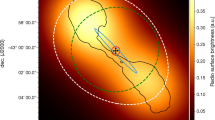Abstract
Hot spots similar to those in the radio galaxy Cygnus A can be explained by the strong shock produced by a supersonic but classical jet\(\left( {u_{jet}< c/\sqrt 3 } \right)\). The high integrated radio luminosity (L≃2×1044 erg s−1) and the strength of mean magnetic field (B≃2×10−4 G) suggest the hot spots are the downstream flow of a very strong shock which generates the ultrarelativistic electrons of energy ɛ≥20 MeV. The fully-developed subsonic turbulence amplifies the magnetic field of the jet up to 1.6×10−4 G by the dynamo effect. If we assume that the post-shock pressure is dominated by relativistic particles, the ratio between the magnetic energy density to the energy density in relativistic particles is found to be ≃2×10−2, showing that the generally accepted hypothesis of equipartition is not valid for hot spots. The current analysis allows the determination of physical parameters inside hot spots. It is found that:
-
(1)
The velocity of the upstream flow in the frame of reference of the shock isu 1≃0.2c. Radio observations indicate that the velocity of separation of hot spots isu sep≃0.05c, so that the velocity of the jet isu jet=u 1+u sep≃0.25c.
-
(2)
The density of the thermal electrons inside the hot spot isn 2≃5×10−3 e − cm−3 and the mass ejected per year to power the hot spot is ≃4M 0yr−1.
-
(3)
The relativistic electron density is less than 20% of the thermal electron density inside the hot spot and the spectrum is a power law which continues to energies as low as 30 MeV.
-
(4)
The energy density of relativistic protons is lower than the energy density of relativistic electrons unlike the situation for cosmic rays in the Galaxy.
Similar content being viewed by others
References
Biermann, P. and Kronberg, P.: 1983,Astrophys. J. 268, L73.
Blandford, R. D. and Rees, M. J.: 1974,Monthly Notices Roy. Astron. Soc. 169, 395.
Galeev, A. A. and Sagdeev, R. Z.: 1969,Non-Linear Plasma Theory, Benjamin, New York.
Ginzburg, V.: 1978,Physique Théorique et Astrophysique, ed. Mir, Moscow.
Hargrave, P. J. and Ryle, M.: 1974,Monthly Notices Roy. Astron. Soc. 166, 305.
Hargrave, P. J. and Ryle, M.: 1976,Monthly Notices Roy. Astron. Soc. 175, 481.
Lacombe, C.: 1977,Astron. Astrophys. 54, 1.
Moffat, H. K.: 1978,Magnetic Field Generation in Electrically Conducting Fluids, Cambridge University Press, p. 280.
Norman, L. M., Smarr, L., Winkler, K. H. A., and Smith, M. D.: 1982,Astron. Astrophys. 113, 285.
Pelletier, G. and Zaninetti, L.: 1984,Astron. Astrophys., (in press).
Perley, R. A., Willis, A. G., and Scott, J. S.: 1979,Nature 281, 437.
Pouquet, A., Frisch, U., and Leorat, J.: 1976,J. Fluid Mech. 77, 321.
Author information
Authors and Affiliations
Rights and permissions
About this article
Cite this article
Pelletier, G., Roland, J. On the velocity of jets powering hot spots similar to those in Cygnus A. Astrophys Space Sci 100, 351–357 (1984). https://doi.org/10.1007/BF00651610
Received:
Issue Date:
DOI: https://doi.org/10.1007/BF00651610




